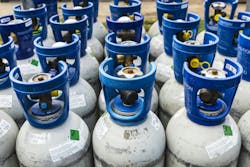Lifecycle Refrigerant Management Creates a Circular Economy for Refrigerant Gases
A Shift in the Narrative:
Reclaimed Refrigerants as the Solution for New Legislation
Refrigerants are a critical component of modern-day society—from enabling air conditioning in buildings and airplanes to ensuring food supply safety. However, as governments and businesses alike look to mitigate negative environmental impacts, refrigerant use has come under close examination in recent years due primarily to the global warming impact of some refrigerants (such as hydrofluorocarbons—HFCs—or hydrochlorofluorocarbons—HCFCs). As a result, reclaimed refrigerants have become a larger part of the conversation around more responsible cooling solutions.
Legislation like the AIM Act has shifted the narrative around the role of reclaimed refrigerant gases as a viable solution for the continued use of refrigerant gases. With the huge amount of legacy equipment using HFCs (not to mention HCFC equipment) still in use, people are looking for ways to use existing equipment while minimizing climate and environmental concerns and limiting over-reliance on virgin refrigerant gases amidst the AIM Act’s nationwide HFC phasedown.
The impact of the phasedown will be seen in an increased demand for reclaimed refrigerants, as these gases do not require the use of HFC quota to be brought back to grade and put back into the market. Reclaimed refrigerants not only provide the necessary means for the continued use of legacy equipment but also ensure the continued availability of refrigerant gases. Lifecycle refrigerant management is a huge component of maintaining the continued availability of refrigerant gases while employing a circular economy approach. As demand for cooling and heating continues to increase, so will the demand for refrigerant gases, opening the market to a risk of tightened supply. Lifecycle refrigerant management is one strategy that can mitigate this issue.
Lifecycle Refrigerant Management:
A New Circular Economy
In the age of sustainability, a concept that has been increasingly pertinent is “circularity” or “circular supply chains.” Circularity refers to the practice of reintegrating a product from the final stage of a typical supply chain back into the nascent product stages. Circular business practices minimize or altogether eliminate the use of virgin raw materials. Circularity, on a large scale, also reduces end-product waste while ensuring the continued availability of products even in the face of supply chain shortages. Circularity becomes especially relevant in the face of supply chain squeezes, such as what is currently happening with HFCs given the AIM Act.
Lifecycle refrigerant management is a circular model for refrigerant gases. Like any supply chain, the lifecycle begins with the manufacturing and supply of the product.
From here, the product gets used. Now, ideally, the used refrigerant gas should be safely recovered according to the specifications of the Environmental Protection Agency (EPA), ensuring compliance with the Federal Clean Air Act. However, because many contractors work on flat-fee models, there’s not a lot of incentive to properly recover gases—a process that requires time and equipment.
Historically, two factors have contributed to a preference for virgin gases over reclaimed gases—the myth that reclaimed gases are inferior in quality and an industry-wide inability to separate mixed refrigerants. The former was never true. Properly reclaimed gases must meet a 99.5% purity threshold as established by the Air Conditioning, Heating, and Refrigeration Institute’s (AHRI) 700 Standard which is the same standard applied to virgin refrigerants. Properly reclaimed gas, meeting the AHRI 700 Standard, is therefore identical to virgin refrigerant. The latter prevented contractors and businesses from recovering used refrigerant for reclamation because there was no economic value for mixed refrigerant (i.e. a reclamation company would not pay for mixed gas).
For contractors and businesses recovering refrigerants, today there is value even in mixed gases. However, it’s crucial to partner with reclamation companies that have invested in state-of-the-art separation technology to ensure an adequate valuation for recovered gas and the most environmentally appropriate handling and processing. This incentivizes refrigerant gas recovery and facilitates reclamation for any refrigerant gas, regardless of its makeup. Working with a reclamation partner that has separation technology and can bundle recovery and reclamation services eliminates business concerns about gas leakage during recovery, mixed refrigerant issues, and more.
A-Gas’ generous buyback program allows businesses and contractors to sell used or stockpiled refrigerants, even if they are mixed. Furthermore, A-Gas' on-site recovery services, provided by A-Gas Rapid Recovery locations throughout the US and globally, offer peace of mind to businesses and contractors that the refrigerant is being safely recovered and transported for reclamation in accordance with EPA and Department of Transportation (DOT) regulations. In addition to recovery and reclamation services, A-Gas offers cylinder swaps for used refrigerant gases—enabling a two-way solution that satisfies refrigerant gas supply needs.
To learn more about the lifecycle refrigerant management services A-Gas offers, click here: https://www.agas.com/us/products-services/refrigerant-services/
Taylor Ferranti is the Commercial Vice President of Refrigerant Management at A-Gas.
